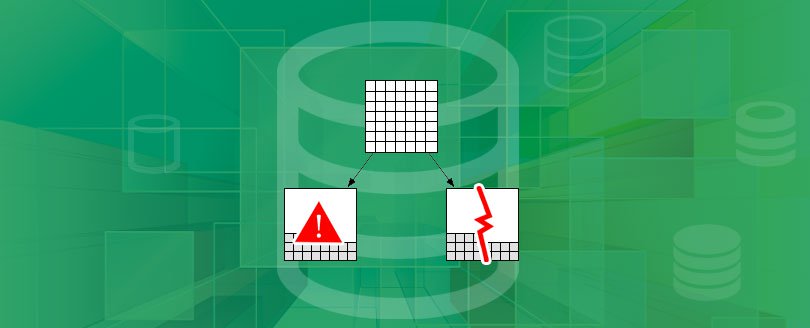Read time 8 minutes
Structured Query Language (SQL) Server is a relational database management system (RDBMS) that helps you to store & retrieve business data. SQL significantly stores your data in an organized manner of rows, columns, tables, etc,. within three files main database file (MDF), secondary files (NDF) & log database files (LDF). In SQL Database, MDF files stores all the primary data, NDF stores additional data and LDF stores log record of data for rollback purposes.
SQL Servers are usually secure but it often faces the issues of database corruption due to multiple reasons. Corruption of your SQL Database puts the entire server data on risk. The issue of SQL corruption can be controlled but if there were no data backups then the damages can be permanent.
Delay in rectifying the problem of your SQL corruption can cause multiple setbacks to you but it’s crucial to analyze the corruption before heading further.
In this blog, we will understand the reasons why SQL Database gets corrupted, precautions during SQL corruption and some effective methods to resolve it.
Reasons for SQL Database corruption
SQL Server databases can get corrupted due to various reasons. MDF files are the primary database files holding the user data, and corruption in them can corrupt the entire database. Multiple reasons can cause MDF corruption, such as:
- Storage media corruption where MDF files are stored.
- Storing SQL database in compressed folders.
- Changes in SQL Server account.
- Accidental data deletion
- File header corruption
- Bugs in disk drivers
- Network failure when database is in working condition.
- Hard disk failure, sudden power failure, unexpected system shutdown, and virus attacks are some of the reasons that can cause MDF corruption.
When an MDF file gets corrupted, SQL database becomes inaccessible. If you try to access the corrupt database, you might get different error messages. Some of the most common error messages are:
- Corruption of data pages.
- Msg 823 error in SQL Server / Msg 824 in SQL Server / Msg 825 (read retry) in SQL Server.
- Error 9004 in SQL Server.
- SQL Server table corruption error.
- Metadata corruption error.
- SQL Server page level corruption
There are several other error messages you might get while trying to open a corrupt SQL database. If you’re a database administrator, you need to act immediately to prevent any data loss.
What to avoid when you face corruption in SQL Database
SQL Database corruption may come as a surprise, but at that time, the most important thing is not to panic as it can worsen the situation. This situation often creates an urgency to repair SQL Database quickly but it’s necessary to be aware of things not to do during SQL Server corruption. Check out the crucial pointers of things not to do during SQL Database corruption.
- Avoid upgrading the server version: Upgrading to the latest version is not the ideal solution to repair the corrupt SQL Database. It can bring new features or fix some bugs, but it will not work to rectify the corruption.
- Do not detach the database: Some users detach their SQL server from a database; it will corrupt and damage their database, and for that reason, they face corruption in the SQL Server.
- Never restart SQL Server: When you are working on your SQL Server and experience some sudden interruptions, then you should not restart SQL Server without saving your data. If you do so, then it will damage and corrupt your SQL database, resulting in many errors in your SQL database.
- Do not shut down the SQL Server: Occasionally, users are working on their SQL Server, and suddenly, their system gets shut down; this will cause many significant problems in their SQL Server.
How to detect corruption in SQL databases?
The main job of the database administrator is to keep the database highly secure and available. When there is corruption in database files, then sometimes it may not show any symptoms of error, but the data remains unavailable. During this time, we don’t recommend you promptly seek ways to repair MS SQL Database as it can cause data loss. That’s why the administrator runs some methods to check for invisible errors in the database.
- Run the database backup along with CHECKSUM
When the Administrator is running database backup process, then they should run the CHECKSUM command along with it. The CHECKSUM command will check the database for any corruption and stop the backup process if it finds any. Run the command and see the results.BACKUP DATABASE XYZ
TO DISK = ‘E:\Database Backup\XYZ.bak’
WITH CHECKSUM;Run the command and see the results.
- Run the DBCC CHECKDB command
DBDC is the command to run the routine checkup of the entire database, and it detects several issues affecting the database.DBCC CHECKDB; The command will check the physical and logical integrity of all the database objects like tables, triggers, relationships, and dependencies. . If there is any problem, then it will be shown in the result with the error message. The error message will clearly show the details, like why it showed the error and stopped the process from finishing.
How to repair corrupt SQL database?
Facing issues of SQL Database corruption ignites the risk of heavy losses of data on your server. Administrators need to look for suitable methods to repair MS SQL database to save crucial business data. There are a few solutions available to repair SQL Server 2014, and other editions. Let’s discuss them in detail.
Method 1. Use log files to restore data
Recovering the data through log files is the most effective way to repair SQL Database. You can use the log files (NDF) of SQL Server to restore the database. However, log files are not sufficient to recover the database in many corruption cases. Sometimes, backup files also get corrupted if the corruption is severe.
Method 2. Use Repair_Rebuild command
Repairing the SQL Database corruption issue using manual methods does not assure to provide expected results. However, Repair_Rebuild command provides better results in primary corruptions. This command will find & fix corrupt pages of your SQL Database with no risk of data loss.
Method 3. DBCC CHECKDB or DBCC DEBREPAIR
Another way to repair the corrupt SQL database is using the database console commands i.e. DBCC CHECKDB and DBCC DEBREPAIR. These commands can detect data loss in your SQL Database. They can be helpful for fixing minor SQL database corruption issues, but they aren’t very efficient for all corruption cases.
How to use the DBCC CHECKDB command to repair SQL?
The syntax of the command is relatively simple:
DBCC CHECKDB ([database_name]) [WITH {NO_INFOMSGS | ALL_ERRORMSGS | DATA_PURITY}] [REPAIR_ALLOW_DATA_LOSS] [REPAIR_FAST] [ESTIMATEONLY] [PHYSICAL_ONLY] [EXTENDED_LOGICAL_CHECKS]
The first parameter indicates which database you want to check, while the additional parameters indicate what kind of checks should be performed & suggests if any SQL repair is needed to be attempted. Here are some of the most common parameters used with this command:
- NO INFOMSGS: Suppress informational messages during the check process.
- ALL ERRORMSGS: Display all error messages that arise from the check process. It’s recommended that you used this option when checking large databases.
- REPAIR_ALLOW_DATA_LOSS: If this option is enabled, then any repairs that need to be done on the database can result in some data loss (such as rows being lost). This option should only be used when necessary, as it could have serious consequences if not used correctly.
- ESTIMATEONLY: Produce an estimate of how long it will take to complete the checks without performing them. This can be quite useful if you want to plan ahead before running a full check on a large database.
- PHYSICAL ONLY: Perform physical consistency checks on the database; no logical consistency checks will be done with this option enabled. It’s best used in conjunction with other parameters like ESTIMATEONLY or REPAIR ALLOW DATA LOSS so that you know exactly what type of check is being performed before starting it.
How to use DBCC CHECKDB command to repair SQL server database via SQL Server Management Studio?
The DBCC CHECKDB command can be used with the SQL Server Management Studio(SSMS) to quickly & easily counter data corruption issues in SQL Server & MDF recovery. Here, we will walk through the steps of how to use the DBCC CHECKDB command to repair a SQL database via SSMS.
- Switch to Emergency mode The first step is to set the database that needs repairing into emergency mode. To do so, you’ll need to execute an ALTER DATABASE statement with the SET EMERGENCY parameter. For eg, if the database that needs to be repaired has the name ‘KernelTesting’, then the command statement will look like this:
ALTER DATABASE [Database Name] SET EMERGENCY
This DBCC CHECKDB example will set the database into emergency mode & allows limited access only for repairs or recovery purposes.
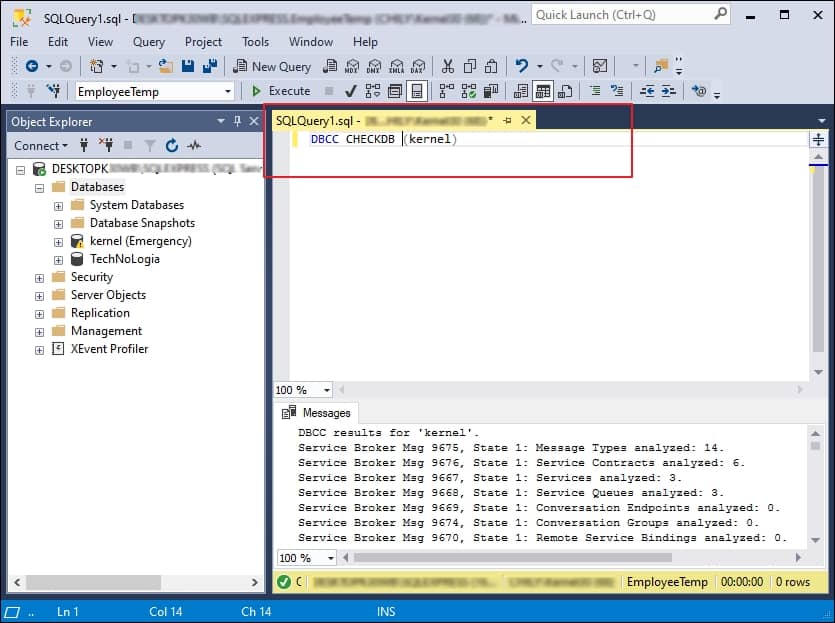
- Checking for corruption
Once the database has been successfully set into emergency mode, you can start checking for corruption errors & other issues that may be causing problems with your database by executing a DBCC CHECKDB example statement like this one:DBCC CHECKDB (Database Name)
This will scan your entire database & check for any errors or inconsistencies. If any such errors are found, they will be listed in the output of this command & you can then proceed to repair SQL Database as needed.
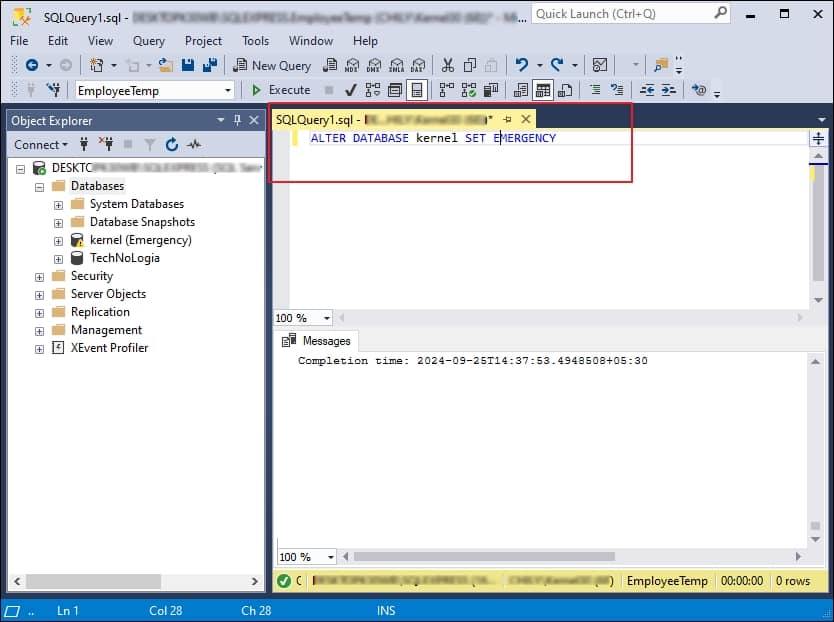
- Setting SINGLE_USER mode
After any errors have been identified, it’s important that you set your SQL Server database into single-user mode before attempting any repairs. For this, type up the following command in SSMS:ALTER DATABASE [Database Name] SET SINGLE_USER WITH ROLLBACK IMMEDIATE
This above DBCC CHECKDB example command prevents other users from accessing your data while you repair SQL Server Database.
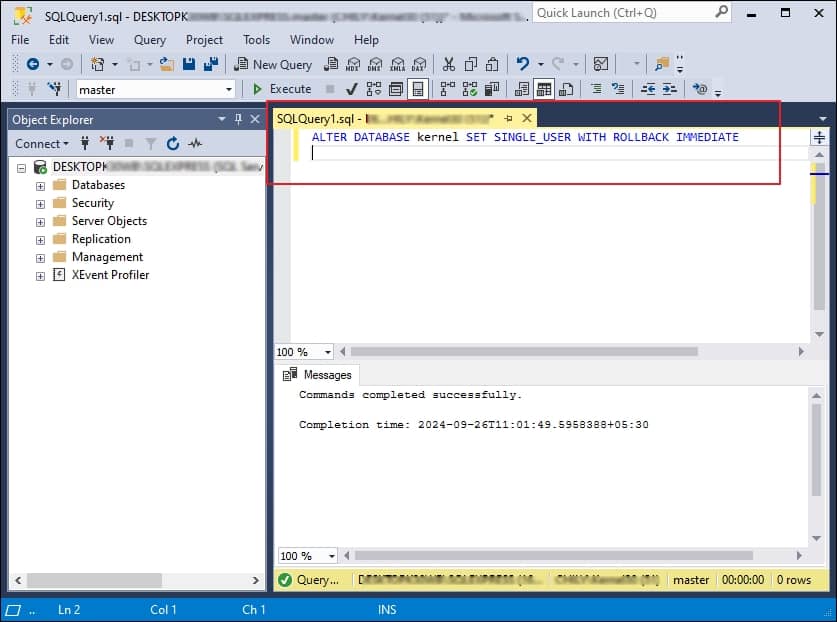
- Database repair
Now that you have set your database into single user mode, you can now proceed with repairing it with this below command:DBCC CHECKDB (N ’Database Name’, REPAIR_ALLOW_DATA_LOSS) WITH ALL_ERRORMSGS, NO_INFOMSGS; GO
This will allow you to repair any corruptions found in the previous step & also allows you to recover lost data from your corrupted database. Note that some data loss may occur during the utilization of DBCC CHECKDB REPAIR_ALLOW_DATA_LOSS process so make sure that you have taken a backup of your original data before proceeding.
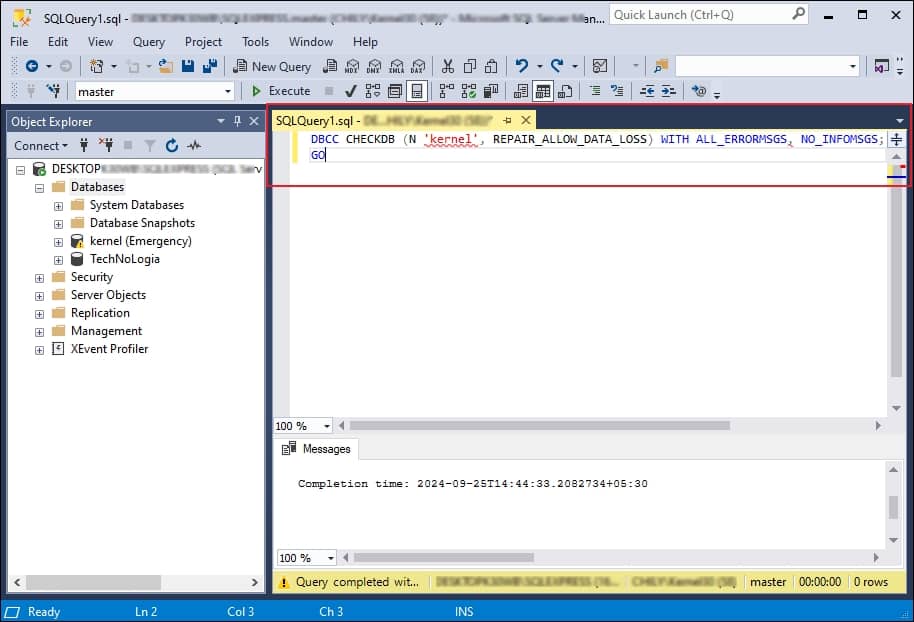
- Switching back To MULTI_USER mode
After successfully repairing your database using DBCC CHECKDB REPAIR_ALLOW_DATA_LOSS command, set it back into multi-user mode by using this command:ALTER DATABASE [Database Name] SET MULTI_USER
The above command allows multiple users to access & modify database within your repaired database simultaneously.
Following these steps carefully after the database backup allows you to restore & repair any corrupt SQL Database or other related damages quickly.
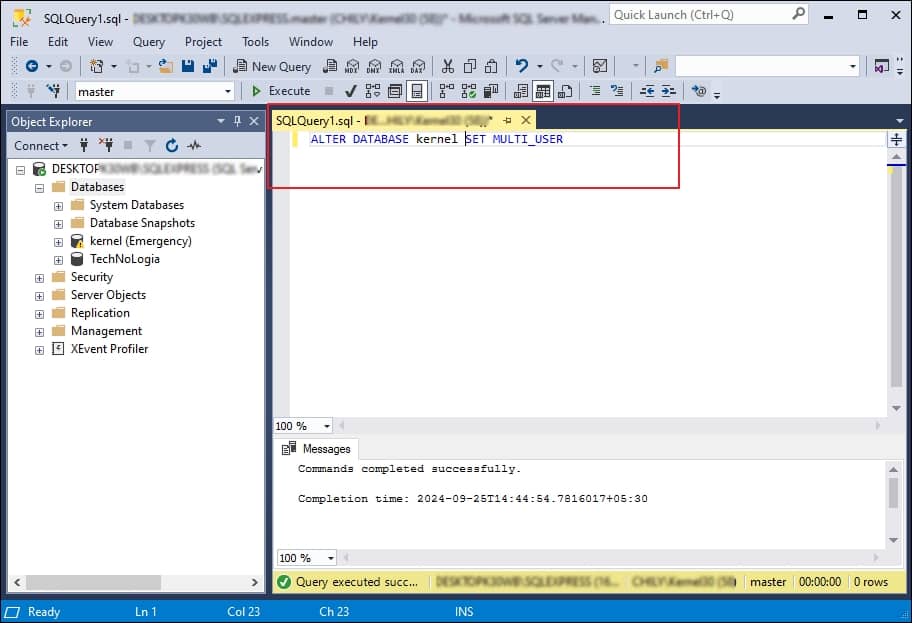
Method 4. Use a professional third-party software
In case of severe corruption in SQL Database, manual methods may not work. Thus, using authentic third-party software is the best way to repair & recover corrupt or damaged SQL databases. Here, we are mentioning an advanced SQL Database repair tool, which is the best software available to repair SQL Database and related corruption errors.
Kernel SQL Database Repair
Kernel for SQL Server Recovery is the best software to deal with all kinds of SQL database corruption issues effectively. The software is extraordinarily programmed to fix all minor and major MDF (primary database files of SQL Server) file corruption issues with accuracy. It ensures effortless database recovery in almost no time without causing any data loss.
In fact, the best and most remarkable aspect of the tool is its ability to quickly repair SQL database and restore all its objects, including Tables, Columns, Indexes, Functions, Values, Keys, Views, Rules, Triggers, Stored Procedures, Checks, Default Values, User data types etc. Adding to that, it even provides complete support to restore multiple MDF files at the same time. No matter whether the size of databases is big or too big, the tool quickly repair MDF file of any size.
Conclusion
In this blog, we have discussed how to repair corrupt SQL Database. The first paragraph of the blog described what an SQL server is and how an SQL database gets corrupted. We also mentioned all the error notifications that a user may face while facing corruption. It will help the user identify corruption the next time. We have also mentioned ways to detect database corruption easily. Lastly, we discussed different manual solutions to repair SQL Database and make it corruption-free.
However, for quick resolution, use the recommended database repair tool to deal with SQL database corruption securely. The tool has a user-friendly interface, which makes it easy for users to repair SQL Server 2019, and earlier versions.






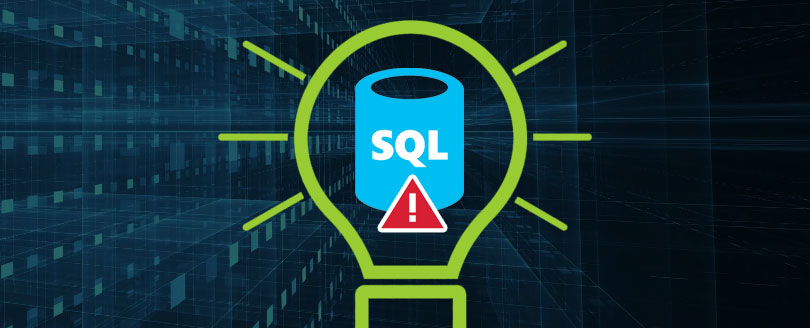
![Resolve SQL Server Error 18456 [100% Working Solutions]](https://www.nucleustechnologies.com/blog/wp-content/uploads/2009/10/error-sql-server-error-starting-esri_sde-service-93-dbms-error-code-18456.jpg)
